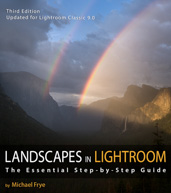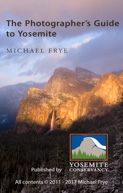Yosemite Photo Conditions
by Michael Frye | Oct 27, 2009 | Yosemite Photo Conditions
 I start teaching a five-day workshop tomorrow, so I won’t have much time for blogging until next week, but thought I’d post a short note about the color in Yosemite Valley. Since I was here four days ago some of the maples have lost their leaves, while the oaks and cottonwoods continue to progress. It looks like my prediction about two color peaks will come true, as the maples are a little past prime now, while the other trees aren’t quite there yet, although they’re progressing quickly and should reach full color soon. The cottonwoods are hard to figure out. Some are bare, and others appear to be only turning partly yellow before shedding their leaves.
I start teaching a five-day workshop tomorrow, so I won’t have much time for blogging until next week, but thought I’d post a short note about the color in Yosemite Valley. Since I was here four days ago some of the maples have lost their leaves, while the oaks and cottonwoods continue to progress. It looks like my prediction about two color peaks will come true, as the maples are a little past prime now, while the other trees aren’t quite there yet, although they’re progressing quickly and should reach full color soon. The cottonwoods are hard to figure out. Some are bare, and others appear to be only turning partly yellow before shedding their leaves.
This photograph of oaks underneath El Capitan was made two years ago. There’s still hope that the oaks could look like that this year!
It’s cold and windy tonight, and some leaves are dropping. There are likely to be more bare maples and cottonwoods tomorrow, but I don’t think the wind will affect the oaks and dogwoods. I’ll post another update as soon as I get a spare moment.
by Michael Frye | Oct 21, 2009 | Yosemite Photo Conditions

We faced rain and wind during Monday’s Fall Color Workshop, but we also found fantastic light and clouds, including a rainbow over Mono Lake. The color is changing rapidly over there. Some aspens were stripped of their leaves during Sunday and Monday’s wind storm, but others have turned from partially green to full yellow. There’s still plenty of color around the June Lake Loop and in Lundy and Lee Vining Canyons. I made this photograph near Silver Lake this morning.
Tioga Pass closed Monday and didn’t reopen until about 10 a.m. today. Driving over the pass to Yosemite Valley this afternoon I found Siesta Lake with it’s usual October ring of red blueberry bushes. I made a detour to check on the dogwoods along Highway 120 west of Crane Flat, and found that almost all turned. In some years the majority of them turn red in this area, but this year most are yellow, although I found a few vivid red specimens.
In Yosemite Valley the big-leaf maples are beautiful. Almost all have turned a rich shade of yellow. The best spots are underneath Cathedral Rocks along Southside Drive and near Curry Village, including the old Lower River Campground area.
The other deciduous trees in the Valley—cottonwoods, oaks, and dogwoods—are still partially to mostly green, except for a few strange cottonwoods that are already bare. So it looks like we’ll have two peaks for color in the Valley: one right now for the maples, and another in one or two weeks for everything else.
The waterfalls got a boost from Monday’s storm. While the flow isn’t close to spring levels, it’s high for October. Upper Yosemite Fall receives early morning sunlight this time of year, something it doesn’t get in spring, so this is a chance to get some unusual photographs of it with good light and fall color in the foreground.
by Michael Frye | Oct 18, 2009 | Yosemite Photo Conditions

After the last storm, many people reported finding little fall color on the east side of the Sierras. Aspens that had already turned yellow were stripped bare by the wind, and the remainder were still green. I was worried that there wouldn’t be anything to photograph during my fall color workshop on Monday.
But those green trees seem to have changed color quickly. I drove over Tioga Pass from Yosemite Valley yesterday afternoon, and breathed a sigh of relief when I caught my first glimpse of Lee Vining Canyon: all yellow. I’d say 80 percent of the trees had turned, and the remainder were yellow-green and should change completely soon.
I found a similar story around the June Lake loop, where about 60 to 70 percent of the aspens had completely turned, and the rest were on their way. I made the accompanying photograph in one of my favorite groves there. Both Lee Vining Canyon and the June Lake Loop were beautiful, and are likely to become even more photogenic in the next few days. I’ll be scouting some other locations today, and I expect to find similar conditions among the lower-elevation aspens. Nancy Boman at Murphey’s Motel in Lee Vining (a photographer’s favorite) told me that the color had arrived just within the last few days, which seems to fit the other reports I’ve heard.
On Friday I was in Yosemite Valley for a private workshop. The most striking change was the amount of water in Yosemite Falls and the Merced River. We had nice morning light on the upper fall and photographed reflections in the river. There was also some mist in the meadows. The water level will drop rapidly during the next week, as there’s not much of a snow pack to feed it, and the mist will also probably dissipate as the meadows dry out, but it might last a few more days.
Fall color in the Valley is developing rapidly. The sugar maple near the chapel is gorgeous, and the native big-leaf maples are about 80 percent turned. The cottonwoods are about halfway there. The dogwoods and oaks are just getting started, but it seems like things are moving quickly, so next weekend might be close to peak. Barring storms, the following weekend (two weeks from now) should also be good.
A minor weather system is expected Monday, and temperatures will drop early next week, so that could change the outlook. But fall-color gloom has turned to hope in just a few days.
by Michael Frye | Oct 14, 2009 | Yosemite Photo Conditions
The storm was as big as advertised, dropping 5.4 inches of rain in Yosemite Valley. Judging from the Tioga Pass web cam, it looks like they got about a foot of snow. Temperatures actually rose during the storm, so the initial snow there turned to rain. The pass is closed, but the park service is apparently plowing, and it may reopen tomorrow.
The rain ended at about 9 a.m. today, and the Turtleback Dome web cam showed some nice clearing storm clouds and mist. There could be good photo opportunities in Yosemite Valley this evening as well. Unfortunately I don’t think I’ll be able to make it up to the valley today. I’ll have to avoid looking at the web cam; if I miss an incredible sunset I’d rather not know! All the moisture in the ground may also lead to mist forming in the meadows on cold evenings or mornings during the next few days.
In addition to lots of rain, the storm brought high winds. I suspect many leaves were blown off aspens on the east side of the Sierra. On the other hand, I heard that the colors are starting to pop in Yosemite Valley. I’ll be up there Friday to see for myself, so I’ll let you know what I find.
by Michael Frye | Oct 11, 2009 | Yosemite Photo Conditions
 The National Weather Service is forecasting a major storm for Yosemite and the Sierra Nevada beginning Monday night and continuing through Tuesday night. The Sierra foothills could get two to three inches of rain and higher elevations could get three to five inches, or two or more feet of snow above 9000 feet. Here a link to the NWS forecast for Yosemite, and their Special Weather Statement.
The National Weather Service is forecasting a major storm for Yosemite and the Sierra Nevada beginning Monday night and continuing through Tuesday night. The Sierra foothills could get two to three inches of rain and higher elevations could get three to five inches, or two or more feet of snow above 9000 feet. Here a link to the NWS forecast for Yosemite, and their Special Weather Statement.
It’s likely that Tioga Pass will close, possibly for several days or more. It’s difficult to know what the effect will be on fall color. The good news is that this storm will be warm, so shouldn’t cause leaves to freeze, wither, and turn brown. But high winds could strip some trees that have already turned. During or just after the storm the rain will enrich the color in moss and leaves. I took advantage of such wet conditions when photographing the oak trees above in Yosemite Valley several years ago.
by Michael Frye | Oct 7, 2009 | Yosemite Photo Conditions

Sunday’s storm added a twist to this year’s fall color story. In my post from September 30th I waxed optimistic about the how the weather conditions—a warm September followed by a cold spell at the beginning of October—might lead to great fall color like we had in 2007. But there’s cold and there’s really cold. Scientists say that the best color comes from sunny days and cool, but not freezing, nights (see Wikipedia and The Buffalo Museum of Science). Temperatures definitely dropped below freezing all over the Sierra on Sunday, as the snow level was down to 5500 feet, and probably reached freezing each subsequent morning in most places above 5000 to 6000 feet.
What usually happens when a cold and windy storm blows through (like we had Sunday) is that trees that have already turned will drop their leaves, and some leaves that are starting to turn will wither and turn brown. I expect that’s already happened to many of the high-elevation aspens in the Eastern Sierra. The good news is that most of the lower-elevation aspens, and virtually all of the deciduous trees in Yosemite, were still green, and were probably unaffected by the storm. The cold weather should start all these trees turning quickly, but during the coming week or so there might not be much color anywhere, as trees that had turned will be bare or withered, and trees that were green will need a week or two to arrive at their peak color. But I’d guess we’ll see some good color among the lower-elevation aspens on the east side in one to two weeks, in the higher-elevation dogwoods in Yosemite (Tuolumne Grove and along Highways 41 and 120) also in one or two weeks, and in Yosemite Valley in two or three weeks. Barring further storms that is.
Since I haven’t been to the east side lately, I’d love to hear from anyone who has, especially if you’ve been there since Sunday and can tell us whether the those high-elevation aspens are bare or withered. Here’s one report from Dan Mitchell that seems to confirm my speculation that some of those upper-elevation trees are past prime.
 I start teaching a five-day workshop tomorrow, so I won’t have much time for blogging until next week, but thought I’d post a short note about the color in Yosemite Valley. Since I was here four days ago some of the maples have lost their leaves, while the oaks and cottonwoods continue to progress. It looks like my prediction about two color peaks will come true, as the maples are a little past prime now, while the other trees aren’t quite there yet, although they’re progressing quickly and should reach full color soon. The cottonwoods are hard to figure out. Some are bare, and others appear to be only turning partly yellow before shedding their leaves.
I start teaching a five-day workshop tomorrow, so I won’t have much time for blogging until next week, but thought I’d post a short note about the color in Yosemite Valley. Since I was here four days ago some of the maples have lost their leaves, while the oaks and cottonwoods continue to progress. It looks like my prediction about two color peaks will come true, as the maples are a little past prime now, while the other trees aren’t quite there yet, although they’re progressing quickly and should reach full color soon. The cottonwoods are hard to figure out. Some are bare, and others appear to be only turning partly yellow before shedding their leaves.











